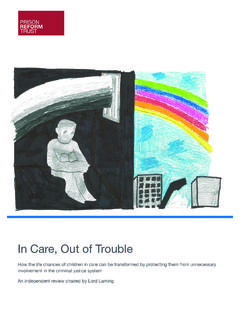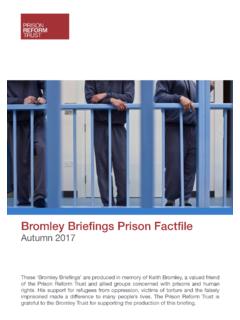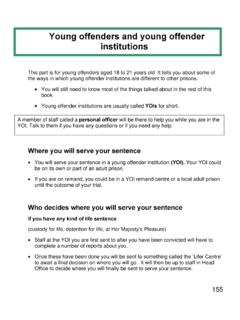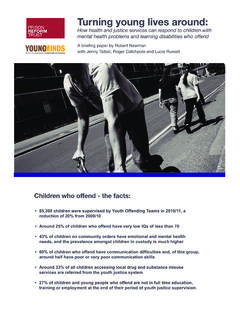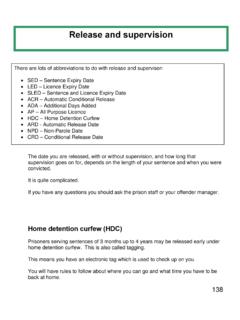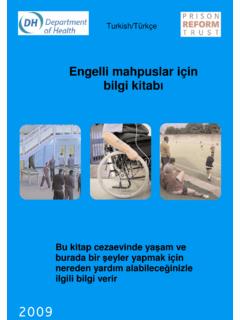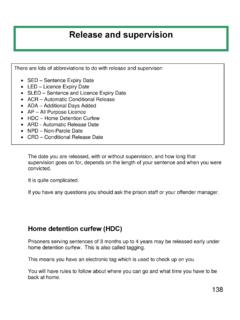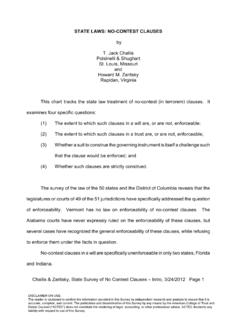Transcription of NO ONE KNOWS - Prison Reform Trust
1 NO ONE KNOWS . offenders with learning difficulties and learning disabilities The prevalence and associated needs of offenders with learning difficulties and learning disabilities Dr Nancy Loucks, independent criminologist and PRT research associate SUMMARY. The literature review on which this briefing paper is based brings together authoritative research on the prevalence and associated needs of offenders with learning difficulties and learning disabilities. The review demonstrates for the first time the vast hidden problem of high numbers of men, women and children with learning difficulties and learning disabilities trapped within the criminal justice system. 20-30% of offenders have learning difficulties or learning disabilities that interfere with their ability to cope within the criminal justice system.
2 This group of offenders: are at risk of re-offending because of unidentified needs and consequent lack of support and services are unlikely to benefit from conventional programmes designed to address offending behaviour are targeted by other prisoners when in custody present numerous difficulties for the staff who work with them, especially when these staff often lack specialist training or are unfamiliar with the challenges of working with this group of people. Background No One KNOWS is a UK-wide programme led by the Prison Reform Trust that aims to effect change by exploring and publicising the experiences of people with learning difficulties and learning disabilities who come into contact with the criminal justice system. The programme runs until October 2008, it is supported by The Diana, Princess of Wales Memorial Fund and is chaired by the Rt Hon the Baroness Joyce Quin, former Prisons Minster for England and Wales.
3 This briefing paper outlines a larger review of prevalence and associated needs compiled to provide background information for No One KNOWS . (Loucks 2006). Most research in the UK and internationally follows a relatively strict definition of learning disability based on IQ measures of 70 or below, or focuses on dyslexia with relatively limited reference to other learning difficulties. No One KNOWS , on the other hand, examines both learning disabilities, as defined in the Valuing People White Paper (Department of Health 2001), and learning difficulties, which include a wider range of impairments such as dyslexia and autistic spectrum disorders. In describing who the programme seeks to benefit, No One KNOWS has purposefully not adopted any crisp definitions of learning difficulties and learning disabilities.
4 Instead, the programme focuses on people within the criminal justice system who have difficulties with certain activities that involve thinking and understanding and who need additional help and support in their everyday living. It is the experiences of this group of people that No One KNOWS will examine. Prevalence and Lancaster 2006; Mottram 2007) compares assessments of prevalence of learning disabilities Even within strict definitions of learning difficulties using three different screening tools in a local and learning disabilities, no agreed levels of Prison , a women's Prison , and a young offender prevalence are evident. While the Department of institution. The researchers found significant Health in England and Wales (1998) estimates that differences in IQ scores between the prisoners 2% of people in the general population have a and standardised norms.
5 About 8% of the general learning disability, researchers disagree whether population scores within the learning disabled or this rate is any higher in populations of offenders. borderline' group. In their research, the overall Estimates of prevalence amongst offenders range average for prisoners assessed either as learning from 0% - 85%, depending on the assessment disabled or borderline learning disabled for the tools used, the stage in the criminal justice three sites was 32%, with assessed as process at which learning disability is assessed, learning disabled, as defined by the Valuing People whether assessments are conducted individually White Paper, and a further as borderline'. or in groups, the level of training of the people Based on a Prison population in England and administering the assessments, and variations in Wales of about 80,000, these figures equate to policies for diversion.
6 Average estimates of over 5,000 people with learning disabilities in prevalence of learning disability amongst offenders Prison on a given day. An additional 19,500. in the UK range from 1 10%. prisoners would be either learning disabled or borderline learning disabled, including 6,800 ( ). The main methods of collecting information on with an IQ between 70 and 74 who would be learning disabilities and offending include considered by community services for people assessments of offending behaviour amongst with learning disabilities (Mottram 2007). people known to learning disability services;. assessing learning disability amongst known Research into learning difficulties amongst offenders; and self-report studies. Research into offenders reveals a similar lack of consensus, people known to specialist services can be though figures appear slightly more consistent.
7 Problematic both because not everyone with a With regard to dyslexia, for example, estimates of learning disability will be in contact with such prevalence amongst offenders range from 4 . services (for example because their disability has 56%. One example of such research in England is not been identified or because of varying criteria John Rack's (2005) research for the Dyslexia for eligibility) and because workers in these Institute in eight prisons in Yorkshire and services may underestimate or indeed deliberately Humberside. Rack's research found that simple under-report criminal activity amongst their interview and screening procedures tend to over- clients. Conversely, assessments of learning estimate rates of dyslexia, while excluding people disability amongst known offenders vary at each with low IQs resulting in under-identification.
8 Rack stage of the criminal justice process as people are found that 40 50% of prisoners were at or diverted from the system. Assessments are not below the level of literacy and numeracy expected conducted routinely and may rely on information of an 11-year old (Level 1), 40% of whom collected prior to reception into custody, for required specialist support for dyslexia. He example, which vary in their accuracy and may concluded that dyslexia is three to four times never reach the relevant Prison or young offender more common amongst offenders than amongst institution. Finally, self-report methods are the general population, with an incidence of 14 . unreliable because of poor accuracy in recall; 31%. hesitance to disclose difficulties or disabilities;. underestimates of significance of behaviour; and a The general agreement in Prison -based studies is tendency for some people to identify themselves a rate of about 30% dyslexia, though rates of as learning disabled when clinical assessments serious deficits in literacy and numeracy in general suggest they fail to meet the formal criteria for reach up to 60%.
9 Deficits in literacy and this. numeracy are often defined as abilities below the age of an 11-year old (Level 1; Rack 2005; Bryan Research conducted by the University of et al. 2004). By serious', however, Herrington Liverpool in three prisons in England (Mottram (2005) reported that the Basic Skills Agency Initial Assessment recorded 60% of prisoners with a the First Night Assessment Form at HMYOI. reading ability equivalent to or less than that of a Brinsford (Bryan et al. 2004). For learning 5-year old child. difficulties (rather than disability), the LADS Plus assessment tool (BDA and HMYOI Wetherby In practical terms, Rack (2005) notes that 20% of 2005; McCaughan 2005) has been piloted, as has a the Prison population have some form of hidden screening checklist for use in prisons developed disability which will affect and undermine their by the Adult Dyslexic Organisation (NIPS 2000).)
10 Performance in both education and work Unfortunately the most widely accepted tools for settings (ibid:2). In similar vein, McBrien (2003) assessment (such as the WAIS-III for learning notes that: disabilities; Kaufman and Lichtenberger 1999) are not appropriate for determining prevalence of One of the most prevalent vulnerable groups learning difficulties and learning disabilities quickly amongst offenders comprises those who do not have and efficiently amongst offenders (Holland 2004), such as for routine screening in prisons. an intellectual disability as formally defined but who do have much lower cognitive and adaptive abilities Methods of assessment of need may not reach a than do either the general population or the offending consensus, but some form of identification is population.
